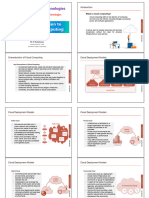Cloud Computing: Revolutionizing IT Infrastructure
Cloud computing has transformed the way organizations manage and utilize IT resources. It refers to
the delivery of computing services—such as storage, servers, databases, networking, and software—
over the internet (“the cloud”). This model eliminates the need for on-premise IT infrastructure,
offering flexibility, scalability, and cost efficiency.
Key Features and Service Models
Cloud computing is characterized by on-demand self-service, broad network access, resource
pooling, rapid elasticity, and a pay-as-you-go pricing model. There are three primary service models:
1. Infrastructure as a Service (IaaS): This model provides virtualized computing
resources over the internet. Examples include Amazon EC2 and Microsoft Azure, where users can
rent servers and storage.
2. Platform as a Service (PaaS): PaaS offers a platform for developers to build, deploy,
and manage applications without worrying about underlying infrastructure. Examples include Google
App Engine and AWS Elastic Beanstalk.
3. Software as a Service (SaaS): SaaS delivers fully functional software applications via
the cloud. Examples include Google Workspace and Microsoft Office 365, allowing users to access
software without installation.
Deployment Models
Cloud computing can be deployed in three main models:
1. Public Cloud: Services are offered over the public internet and shared among
multiple users. Examples include AWS, Google Cloud, and Microsoft Azure.
2. Private Cloud: A dedicated cloud environment for a single organization, ensuring
greater control and security.
3. Hybrid Cloud: Combines public and private clouds to provide a mix of flexibility and
security, making it ideal for organizations with varied workloads.
Benefits of Cloud Computing
Cloud computing offers several advantages that make it indispensable in today’s digital era:
• Cost Efficiency: Organizations can reduce capital expenditures by paying only for the
resources they use.
� • Scalability: Resources can be adjusted to meet fluctuating demands, ensuring
optimal performance.
• Accessibility: Cloud services can be accessed from anywhere with an internet
connection, enabling remote work and collaboration.
• Disaster Recovery: Cloud providers offer robust backup and disaster recovery
solutions.
• Collaboration: Teams can work together in real-time using shared tools and
resources hosted in the cloud.
Challenges of Cloud Computing
Despite its benefits, cloud computing has its challenges:
• Security and Privacy: Storing sensitive data on third-party servers raises concerns
about unauthorized access.
• Downtime: Internet outages or server failures can disrupt access to cloud services.
• Compliance: Organizations must ensure their cloud usage adheres to industry-
specific regulations.
• Internet Dependence: Reliable internet connectivity is a prerequisite for accessing
cloud services.
Applications and Future Trends
Cloud computing is used across industries. In education, it supports e-learning platforms and virtual
labs. Healthcare leverages it for telemedicine and medical record storage. Entertainment relies on
cloud infrastructure for streaming services like Netflix.
The future of cloud computing is promising, with trends like the integration of artificial intelligence
and machine learning, advancements in edge computing, and a growing focus on sustainability in
cloud operations. As organizations continue to adopt serverless computing and hybrid cloud
solutions, the cloud will remain a cornerstone of digital transformation.
Cloud computing has redefined IT infrastructure, providing unprecedented flexibility and innovation.
Its evolution will further shape how businesses and individuals interact with technology.





















































































